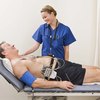A Holter monitor is a personal device that records a patient’s heart activity for 24 hours while the person being monitored attends to his daily routine. The monitor can help pinpoint symptoms of dizziness, heart palpitations and blackouts and correlate these events with the data captured on the monitor. This observational process is far more effective than a standard EKG because it measures heart activity nonstop for 24 hours while a standard EKG lasts no longer than a minute. A nurse or monitor technician sets up the test by applying the apparatus directly to the patient.
Inform the patient she must wear loose, comfortable clothing for the duration of the test, a 24-hour period. Prior to the exam, explain that a button-down shirt or blouse is best to wear over the electrodes. The patient may not shower during the test period. Encourage the patient go about his normal daily activities, including work, errands and household activities. Inform the patient that he must avoid any electrical appliances that might interfere with the EKG signal, such as an electric razor, hairdryer or toothbrush and also large magnets, metal detectors and electric blankets.
Shave a man’s chest only in the spots where his hair interferes with the sticky electrodes. Cleanse the chest area with alcohol where the electrodes are to be applied -- two at the apex of the pectoral muscles, 3 inches below the neck; one below the breastbone in the middle of the chest; and two more directly below each breast.
Plug the cables from the electrodes into the Holter monitor and set the monitor to the proper electrode configuration. Relax the patient while you apply the electrodes to her skin by having her keep her arms down at her side. Select the lead placement menu on the Holter monitor and enter "5" into the electrode configuration category.
Help the patient with the shirt or blouse to ensure the electrodes remain adhered to the skin while dressing. The adhesive should firm up in just a few minutes, so the chance of an electrode falling off gradually becomes less of a problem. Assist the patient with the Holter device, either with a shoulder strap or through a belt loop to be worn around the waist. Inform the patient to call the doctor’s office if any problems with the equipment arises, and leave the phone number she may call.
Inform the patient he is to keep a diary or log of all activity for the duration of the test, including the time of day and length of time engaged in the activity. The patient should also include such details as dizziness, skipped heartbeats, chest discomfort and emotional well-being, such as being upset or worried. Instruct the patient on how to remove the electrodes at the conclusion of the 24-hour test period or that he may come into the office for help.
Tip
Some monitors include an event button. Pressing the button when the patient has an event, such as chest discomfort or dizziness, helps the technician pinpoint the exact time of the event with the printout of the electrocardiogram (ECG).
References
Writer Bio
Barry Index lives in Los Angeles where he has been writing about writing since 1998. Recent freelance activities have brought his work to wider audiences through FictionAnitdote.com and several other writer-enthusiast sites. He received his Bachelor of Arts degree in English from California State University, Northridge.
Image Credit
electrode sèche image by YvesBonnet from Fotolia.com




